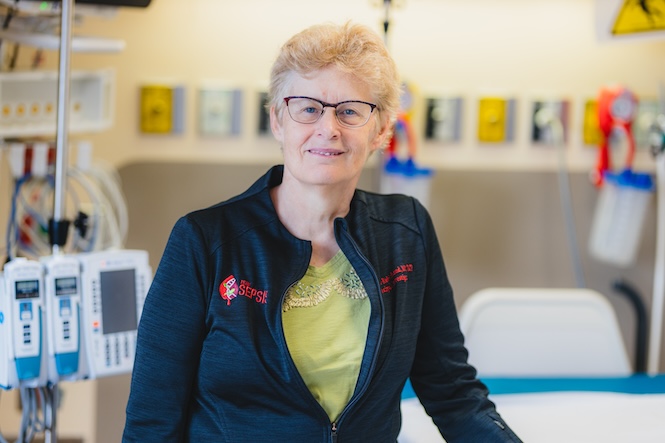
Dr. Alison Fox-Robichaud’s passion for research dates back to her teenage years, when she spent the summer between high school and university working at a McMaster University research lab.
“From the time I graduated high school, and every summer in university, I worked in a lab,” says Fox-Robichaud, who has gone on to build an illustrious career as a Hamilton Health Sciences (HHS) critical care physician, national sepsis expert and researcher at the Thrombosis & Atherosclerosis Research Institute (TaARI) of HHS and McMaster. She is also the HHS chair in sepsis research.
“Dr. Fox-Robichaud has been instrumental, locally and nationally, in raising awareness of sepsis including its long-term impacts,” says Dr. Marc Jeschke, vice president of research and chief scientific officer for HHS.
“As well as caring for our sickest patients, her leading-edge research focuses on saving lives and improving the quality of life for sepsis patients and survivors, and she is accomplishing this through various unique and highly-impactful approaches.”
Fox-Robichaud is sharing more about her roles in health care including sepsis research for World Sepsis Day on Sept. 13.
Discovering her life’s work
Fox-Robichaud also mentors the next generation of doctors as a professor of medicine at McMaster University and as director of medical education at HHS. As a young adult, her own mentor was her mother — Dr. Jo-Ann Fox-Threlkeld, a professor emeritus at McMaster. Fox-Threlkeld worked in a research lab and was one of the first nurses in Canada to earn a PhD in physiology. “My mother was a nurse scientist, and my role model,” says Fox-Robichaud.
“Dr. Fox-Robichaud has been instrumental, locally and nationally, in raising awareness of sepsis including its long-term impacts”
Fox-Robichaud cares for critically-ill patients, including people with sepsis, in HHS Hamilton General Hospital’s intensive care unit (ICU), while also researching sepsis. This disease is caused by an out-of-control response to an infection, and is the deadliest health condition in the world, killing more people globally than cancer.
Back in her student days, her internal medicine residency experience in Calgary set her course to become a bench-to-bedside sepsis researcher. “I found the ICU in my second year of residency and I have not looked back,” says Fox-Robichaud, adding that this was also the time in her life when she developed a keen interest in sepsis research and caring for patients with this disease.
“When doing my residency I came to realize that that the one disease I felt passionate about was sepsis.”
While completing her residency, she spent all her electives and any spare time working in a lab. “I was bound and determined to be a bench clinician scientist.” Bench clinician scientists are physicians or other health-care professionals who care for patients and also conduct wet lab research, which involves handling liquids, biological matter and chemicals.
Studying sepsis
After completing her residency, Fox-Robichaud returned to McMaster, where she was hired as a bench scientist focused on critical care. She worked for close to seven years in that position before taking on the role of local principal investigator on her first clinical trial involving sepsis patients. Many research projects followed over the years including being site lead for large Canadian Institutes of Health Research (CIHR) studies and leading some industry-funded studies.
She is currently the lead for an HHS drug repurposing study looking at treating patients with sepsis in the ICU. She is also the local principal investigator for another three clinical trials currently underway, and one about to start.
Over the past few years, Fox-Robichaud also became involved in health services research, related to reducing sepsis rates. Preventing hospital-acquired sepsis is strategic priority for HHS.
A new focus
Health services research focuses on improving the efficiency and effectiveness of health professionals and the health-care system through changes to practice and policy. It can include studying social factors, financing systems, organizational structures and processes, health technologies, and personal behaviours affecting access to health care, the quality and cost of health care, and, ultimately, people’s health and well-being. This branch of research led to her becoming scientific director for Sepsis Canada.
Making sepsis a local and global priority
In 2017, the World Health Organization identified sepsis as a global health priority, urging countries to take steps to reduce the burden of sepsis through improved prevention, diagnosis and management.
In response, the CIHR funded Sepsis Canada – a national research network aimed at further understanding the causes of sepsis; improving prevention, detection, and management; and supporting recovery and
rehabilitation.
“Some of the research I’m most passionate about is finding tools to more quickly recognize sepsis,” says Fox-Robichaud. “Whether it’s in hospital or in the community, we need better tools to recognize sepsis. Early warning system scores are one of those tools.”
One of her early health services projects was the development of the Hamilton Early Warning Score (HEWS) at HHS. HEWS is used by hospital care teams to recognize the early signs of diseases in order to intervene and
management them early.
Fox-Robichaud is also interested in research aimed at supporting sepsis survivors. Post-sepsis syndrome affects up to half of sepsis survivors, with long-term side effects that can include difficulty sleeping, severe muscle and joint pain, decreased cognitive function, kidney failure and respiratory
problems.
“There isn’t a lot of research into survivorship, so we don’t understand this patient population well,” says Fox-Robichaud. “I’m very interested in studies looking into how we can help our sepsis survivors at HHS.” nH

